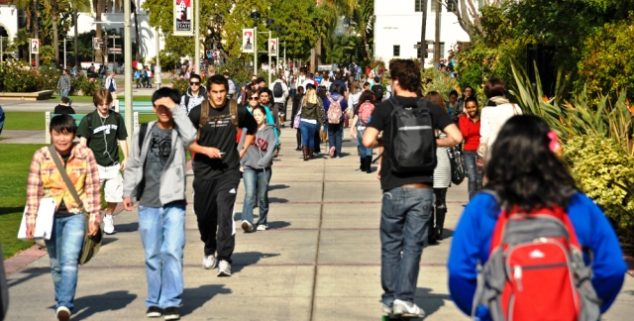News
California students’ aid requests show decline
 Students at San Diego State University, pre-pandemic. (Photo: Pictor Picture, via Shutterstock)
Students at San Diego State University, pre-pandemic. (Photo: Pictor Picture, via Shutterstock)A long and steady increase in the number of California students seeking financial aid came to an abrupt end this year, and while it’s too soon to know exactly why 25,000 fewer students filled out federal aid forms than last year, all signs point to the pandemic.
“There’s not enough data yet to get to the exact reasons,” Kevin Cook, associate center director at the Public Policy Institute of California, who wrote about the decline on the institute’s website.
California is not alone in the decline, but with a 9.7 percent drop, the Golden State sustained a greater dip than the 9-percent national average.
He said, though, it appeared that after either witnessing or hearing about the limitations of distance learning, “some students may have decided to take a year off.”
That tracks with the initial data. The biggest decline was among first-year students, who may have seen and heard too much about Zoom classes to be enthused.
Even in a good year — and last year, with more than a quarter-million applications, was a good year — just over half of California’s student population fills out the all-important FAFSA (Free Application for Federal Student Aid) form.
Changes at the federal level will streamline that form, eliminating questions and making it easier to complete. But students won’t see those changes for a couple years.
California is not alone in the FAFSA decline, but with a 9.7 percent drop, the Golden State sustained a greater dip than the 9-percent national average.
And that variance of decline between different states indicates that simply blaming the pandemic won’t offer a full explanation. Other populous states did not see as big a drop as California. Texas, for example, posted an 8.3 percent decline; Florida went down 7.7 percent; and Illinois dropped only 3.7 percent.
“Clearly the impact is greater on lower-income students, which is exactly who we’re trying to serve.” — Kevin Cook
The deadline passed earlier this month.
“This bucks a trend,” said Cook, noting that application rates here have been inching their way up for the last couple decades.
And the closer you look, the more concerning it is. Most of the drop was among high school seniors and those in their first year of college.
Cook also noted a “concentration [of decline] among underrepresented and minority students,” the exact population most likely to have suffered income loss during the pandemic.
“Clearly the impact is greater on lower-income students, which is exactly who we’re trying to serve,” he said.
Receiving aid, he added, does more than help pay the bills. Research has shown, he said, that recipients of aid are more likely to complete their courses and graduate.
As advocates and policymakers tease through the data and prepare for next year’s applications, many of them will be focused on recapturing what was lost in the pandemic.
“We want to find those who have fallen out of the college pipeline and put back in the pipeline,” he said, adding, “If they want to be.”
Want to see more stories like this? Sign up for The Roundup, the free daily newsletter about California politics from the editors of Capitol Weekly. Stay up to date on the news you need to know.
Sign up below, then look for a confirmation email in your inbox.

Leave a Reply